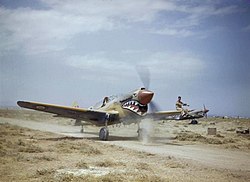No. 212 Group
July 1942 | Nos. 211 & 212 Groups
27 October 1942 | No. 211 Group
10 July 1943 |
|---|
| No. 233 Wing RAF/7 Wing SAAF | No. 233 Wing [211 Group] - No. 2 Squadron SAAF (16 x Kittyhawks I, II & III)
- No. 4 Squadron SAAF (16 x Kittyhawks I, II & III)
- No. 5 Squadron SAAF (16 x Tomahawks)
- No. 260 Squadron RAF (16 x Kittyhawks I & IIb)
| No. 7 Wing SAAF - No. 2 Squadron SAAF, Spitfire
- No. 4 Squadron SAAF, Spitfire
- No. 5 Squadron SAAF, Kittyhawk
- See No. 239 Wing
|
| 7 Wing SAAF | No. 7 Wing SAAF [No. 212 Group]
No. 80 Squadron SAAF (16 x Hurricane IIc)
No. 127 Squadron SAAF (16 x Hurricane IIb)
No. 274 Squadron SAAF (16 x Hurricane IIb)
No. 335 (Greek) Squadron (16 x Hurricane IIb) | |
| No. 239 Wing RAF | No. 239 Wing [211 Group]
-
No. 112 Squadron RAF (16 x Kittyhawk IA)
No. 250 Squadron RAF (16 x Kittyhawk IIA)
No. 260 Squadron RAF (16 x Tomahawks)
66th Fighter Squadron (USAAF) (18 x P-40F Warhawks) | No. 239 Wing RAF
No. 3 Squadron RAAF, Kittyhawk
No. 112 Squadron RAF, Kittyhawk
No. 250 Squadron RAF, Kittyhawk
No. 260 Squadron RAF, Kittyhawk
No. 450 Squadron RAAF, Kittyhawk |
| No. 244 Wing RAF | No. 244 Wing RAF [211 Group] - No. 73 Squadron RAF (16 x Tomahawks IIb)
- No. 92 Squadron RAF (16 x Spitfires Vc)
- No. 145 Squadron RAF (16x Spitfires Vb)
- No. 601 Squadron RAF (16x Spitfires Vb)
| No. 244 Wing
1 Squadron SAAF, Spitfire
No. 92 Squadron RAF, Spitfire
No. 145 Squadron RAF, Spitfire
No. 417 Squadron RCAF, Spitfire
No. 601 Squadron RAF, Spitfire |
| No. 243 Wing RAF | No.243 Wing RAF [No. 212 Group] - No.1 Squadron SAAF (16 x Hurricane IIc)
- No. 33 Squadron RAF (16 x Hurricane IIc)
- No. 213 Squadron RAF (16 x Hurricane IIb)
- No. 238 Squadron RAF (16 x Hurricane IIb)
| No. 322 Wing RAF
Colin Falkland Gray (RNZAF) |
| Other | Other Squadrons: | No. 324 Wing RAF
No. 43 Squadron RAF, Spitfire
No. 72 Squadron RAF
No. 93 Squadron RAF, Spitfire
No. 111 Squadron RAF, Spitfire
No. 243 Squadron RAF, Spitfire
- |
| Other Units: | No. 212 Group was assigned to:
Air H.Q. Air Defences Eastern Mediterranean
and 211 Group was assigned to:
Air H.Q. Western Desert in February 1943. | Other: |




